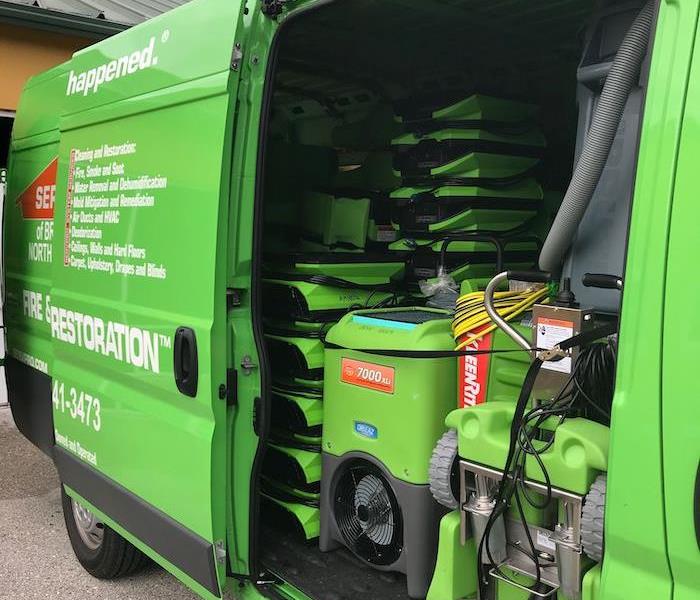What Are Efficient Strategies for Restoring Flood Damages in My Little Falls Home?
12/15/2020 (Permalink)
 Homeowners have to deal with many things which may include storm damage. Don't let the moisture take over your home. Contact SERVPRO right away.
Homeowners have to deal with many things which may include storm damage. Don't let the moisture take over your home. Contact SERVPRO right away.
Many steps can be taken to make the restoration and repair of a flood-damaged home more efficient and cost-effective.
Understanding the full measure of the flood restoration process for your Little Falls home can ensure that the appropriate professionals get called to respond to these disasters when necessary. Flood restoration involves multiple repair and cleaning stages, both of which our extensive roster of qualified professionals can provide. Understanding what is involved in returning your home to a preloss condition after a flood can show homeowners how vital professional recovery actually is for residences and businesses alike.
When considering how extensive flood damage in Little Falls homes can become, containment and emergency services become vital efforts to begin immediately. Often, these preliminary tasks occur before mitigation or the job scoping phase. Planning is a considerable step and stage before restoration begins, but there are specific actions they cannot wait to be included in this overall restoration agenda. We have several efficient strategies beginning with your communication with our staffed SERVPRO emergency line.
When is the Information About the Disaster Gathered?
As you might expect, our professionals cannot know about damages to your specific residence without first notifying our administrators about the issue. The information you share with our staff emergency line representatives is shared directly with the appropriate parties responding to the disaster. At this stage, it is critical to be as thorough as possible so that we can collect the proper data and relevant facts to ensure that our technicians mobilize from our warehouse with the right equipment, personnel, and products. There are three ultimate ways that we collect the bulk of the data necessary to form our restoration plan for the property:
- Emergency Phone Call – As already discussed, the more that you can share with operators on our emergency line, the better prepared our technicians are for what to expect when we reach the property.
- Job Scoping – We have highly trained project managers who walk through the property damaged by a flood to determine what actions must be taken to restore the home. We can also use this phase to document total losses of structures and contents or indicate where further measures might be required in these areas.
- Conversations with the Customer – No one knows your property as well as you do, so we often lean on the information provided by our customers to prioritize what actions get taken first.
What is a Staging Area?
One of the efficient recovery approaches that our SERVPRO technicians utilize is staging areas. These get constructed in unaffected areas of the home nearby to where the bulk of the work and cleaning must occur. The objective of establishing a clean room to store equipment and personal protective gear is to have these items accessible as they are needed. We can limit trips in and out of the house by bringing in all of the necessary equipment, products, and devices into this staging area. The primary advantages of establishing this cleanroom between your home and its damaged areas are:
- Efficient
- Convenient
- Prevents Cross-Contamination
- Near to Drying/Work Zones
What Are Efficient Strategies for Extraction?
Flood losses can be traumatic events in your house, specifically when standing water becomes a pressing concern. In any capacity, pooling can lead to saturation and absorption into the exposed materials of contents nearby. Extraction becomes a critical effort for our responding technicians because this removes the standing water threat to allow for more focus drying, cleaning, and other recovery actions. There are several extractors common to removing natural flood water from a property, whether inside the house, in the crawl space area, or even more inaccessible locations. These approaches include:
- Trash Pumps – Gas-powered trash pumps can often be an ideal choice for removing natural flood water because of these units’ ability to remove smaller solids and debris.
- Wet Vacuums – Extractors like wet vacuums are a more versatile choice, as these can run several different attachments such as carpet wands, squeegee wands, or work independently to remove water below two inches in depth.
- Subcontractor – Threat of contamination can be a motivator to choose a subcontractor where blackwater incidents might be overwhelming for the equipment available to our SERVPRO team.
Many initial tasks must occur between the potential for contamination and leftover bulk materials immediately following the disaster. Our SERVPRO of Clifton team has motivated and helpful water restoration technicians and cleaning specialists to help address drying and restoring the property “Like it never even happened.” Give us a call today at (973) 928-3705.






 24/7 Emergency Service
24/7 Emergency Service